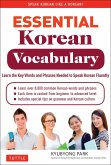Young-Key Kim-Renaud
Korean: An Essential Grammar
Young-Key Kim-Renaud
Korean: An Essential Grammar
- Gebundenes Buch
- Merkliste
- Auf die Merkliste
- Bewerten Bewerten
- Teilen
- Produkt teilen
- Produkterinnerung
- Produkterinnerung
Presenting a fresh and accessible description of the language, this engaging grammar uses clear, jargon-free explanations to give a concise and convenient guide to the basic grammatical structure of Standard Korean.
Andere Kunden interessierten sich auch für
![Modern Korean: An Intermediate Reader Modern Korean: An Intermediate Reader]() Michael Namkil KimModern Korean: An Intermediate Reader35,99 €
Michael Namkil KimModern Korean: An Intermediate Reader35,99 €![Innovative Methods in Korean Language Teaching Innovative Methods in Korean Language Teaching]() Innovative Methods in Korean Language Teaching197,99 €
Innovative Methods in Korean Language Teaching197,99 €![Korean Conversation Gambits: Developing Spoken Language Korean Conversation Gambits: Developing Spoken Language]() Heekyung AhnKorean Conversation Gambits: Developing Spoken Language197,99 €
Heekyung AhnKorean Conversation Gambits: Developing Spoken Language197,99 €![Essential Korean Vocabulary Essential Korean Vocabulary]() Kyubyong ParkEssential Korean Vocabulary25,99 €
Kyubyong ParkEssential Korean Vocabulary25,99 €![Selected Readings in Korean Selected Readings in Korean]() Ho-Min SohnSelected Readings in Korean40,99 €
Ho-Min SohnSelected Readings in Korean40,99 €![Frontiers of Translation in Korean Language Education Frontiers of Translation in Korean Language Education]() Frontiers of Translation in Korean Language Education200,99 €
Frontiers of Translation in Korean Language Education200,99 €![Hangeul: Korea's Unique Alphabet Hangeul: Korea's Unique Alphabet]() Robert KoehlerHangeul: Korea's Unique Alphabet14,99 €
Robert KoehlerHangeul: Korea's Unique Alphabet14,99 €-
-
-
Presenting a fresh and accessible description of the language, this engaging grammar uses clear, jargon-free explanations to give a concise and convenient guide to the basic grammatical structure of Standard Korean.
Hinweis: Dieser Artikel kann nur an eine deutsche Lieferadresse ausgeliefert werden.
Hinweis: Dieser Artikel kann nur an eine deutsche Lieferadresse ausgeliefert werden.
Produktdetails
- Produktdetails
- Verlag: Taylor & Francis
- Seitenzahl: 272
- Erscheinungstermin: 28. Mai 2009
- Englisch
- Abmessung: 234mm x 156mm x 16mm
- Gewicht: 558g
- ISBN-13: 9780415385138
- ISBN-10: 041538513X
- Artikelnr.: 42195351
- Herstellerkennzeichnung
- Libri GmbH
- Europaallee 1
- 36244 Bad Hersfeld
- gpsr@libri.de
- Verlag: Taylor & Francis
- Seitenzahl: 272
- Erscheinungstermin: 28. Mai 2009
- Englisch
- Abmessung: 234mm x 156mm x 16mm
- Gewicht: 558g
- ISBN-13: 9780415385138
- ISBN-10: 041538513X
- Artikelnr.: 42195351
- Herstellerkennzeichnung
- Libri GmbH
- Europaallee 1
- 36244 Bad Hersfeld
- gpsr@libri.de
Young-Key Kim-Renaud is Professor of Korean Language and Culture and International Affairs, and Chair of the Department of East Asian Languages and Literatures at the George Washington University in DC.
Preface List of Abbreviations and Notations Glossary 0. Introduction Korean
and its speakers 1. Writing system 2.1. History 2.2. Inventory 2.3.
Romanization 2. Pronunciation 2.1. The Syllable 2.2. Consonants 2.3. Vowels
2.4. Intonation 3. Sentence 3.1. The elements of a simple sentence 3.1.1.
Subject 3.1.2. Object 3.1.2. Predicate 3.2. Sentence patterns 3.3. Basic
word order 4. Words 4.1. Types of vocabulary 4.2. Expanding words 5. Verbs
5.1. Action verbs 5.2. Descriptive verbs 5.3. Two kinds of 'be' 5.4. Making
new verbs 5.5. Marking time and aspect 5.6. Honorification 5.6.1. Subject
honorification 5.6.2. Addressee honorification 5.6.3. Reference
honorification 5.7. Causatives and passives 6. Nouns, pronouns,
classifiers, noun phrases 6.1. Proper and common nouns 6.2. Pronouns 6.3.
Numerals and numeral classifiers 6.3. Making new nouns 6.4. Making noun
phrases 6.5. Noun compounds 6.6. Word order in noun phrases 6.7. Case
marking 7. Modifiers 7.1 Adverbs 7.2 Noun modifiers 7.3 Deictics 8. Mimetic
words 8.1. Reduplication 8.2. Vowel 9. Negation 9.1. Short-form 9.2.
Long-form 10. Expanded sentences 10.1. Compound sentences 10.2. Complex
sentences 11. Casual speech 12. Linguistic protocol 12.1. Choosing the
appropriate speech form 12.2. Honorific readjustments and politeness
strategies 12.3. Language, ideology, and society Glossary of terms with
explanations List of particles, suffixes, and sentential endings Further
reading
and its speakers 1. Writing system 2.1. History 2.2. Inventory 2.3.
Romanization 2. Pronunciation 2.1. The Syllable 2.2. Consonants 2.3. Vowels
2.4. Intonation 3. Sentence 3.1. The elements of a simple sentence 3.1.1.
Subject 3.1.2. Object 3.1.2. Predicate 3.2. Sentence patterns 3.3. Basic
word order 4. Words 4.1. Types of vocabulary 4.2. Expanding words 5. Verbs
5.1. Action verbs 5.2. Descriptive verbs 5.3. Two kinds of 'be' 5.4. Making
new verbs 5.5. Marking time and aspect 5.6. Honorification 5.6.1. Subject
honorification 5.6.2. Addressee honorification 5.6.3. Reference
honorification 5.7. Causatives and passives 6. Nouns, pronouns,
classifiers, noun phrases 6.1. Proper and common nouns 6.2. Pronouns 6.3.
Numerals and numeral classifiers 6.3. Making new nouns 6.4. Making noun
phrases 6.5. Noun compounds 6.6. Word order in noun phrases 6.7. Case
marking 7. Modifiers 7.1 Adverbs 7.2 Noun modifiers 7.3 Deictics 8. Mimetic
words 8.1. Reduplication 8.2. Vowel 9. Negation 9.1. Short-form 9.2.
Long-form 10. Expanded sentences 10.1. Compound sentences 10.2. Complex
sentences 11. Casual speech 12. Linguistic protocol 12.1. Choosing the
appropriate speech form 12.2. Honorific readjustments and politeness
strategies 12.3. Language, ideology, and society Glossary of terms with
explanations List of particles, suffixes, and sentential endings Further
reading
Preface List of Abbreviations and Notations Glossary 0. Introduction Korean
and its speakers 1. Writing system 2.1. History 2.2. Inventory 2.3.
Romanization 2. Pronunciation 2.1. The Syllable 2.2. Consonants 2.3. Vowels
2.4. Intonation 3. Sentence 3.1. The elements of a simple sentence 3.1.1.
Subject 3.1.2. Object 3.1.2. Predicate 3.2. Sentence patterns 3.3. Basic
word order 4. Words 4.1. Types of vocabulary 4.2. Expanding words 5. Verbs
5.1. Action verbs 5.2. Descriptive verbs 5.3. Two kinds of 'be' 5.4. Making
new verbs 5.5. Marking time and aspect 5.6. Honorification 5.6.1. Subject
honorification 5.6.2. Addressee honorification 5.6.3. Reference
honorification 5.7. Causatives and passives 6. Nouns, pronouns,
classifiers, noun phrases 6.1. Proper and common nouns 6.2. Pronouns 6.3.
Numerals and numeral classifiers 6.3. Making new nouns 6.4. Making noun
phrases 6.5. Noun compounds 6.6. Word order in noun phrases 6.7. Case
marking 7. Modifiers 7.1 Adverbs 7.2 Noun modifiers 7.3 Deictics 8. Mimetic
words 8.1. Reduplication 8.2. Vowel 9. Negation 9.1. Short-form 9.2.
Long-form 10. Expanded sentences 10.1. Compound sentences 10.2. Complex
sentences 11. Casual speech 12. Linguistic protocol 12.1. Choosing the
appropriate speech form 12.2. Honorific readjustments and politeness
strategies 12.3. Language, ideology, and society Glossary of terms with
explanations List of particles, suffixes, and sentential endings Further
reading
and its speakers 1. Writing system 2.1. History 2.2. Inventory 2.3.
Romanization 2. Pronunciation 2.1. The Syllable 2.2. Consonants 2.3. Vowels
2.4. Intonation 3. Sentence 3.1. The elements of a simple sentence 3.1.1.
Subject 3.1.2. Object 3.1.2. Predicate 3.2. Sentence patterns 3.3. Basic
word order 4. Words 4.1. Types of vocabulary 4.2. Expanding words 5. Verbs
5.1. Action verbs 5.2. Descriptive verbs 5.3. Two kinds of 'be' 5.4. Making
new verbs 5.5. Marking time and aspect 5.6. Honorification 5.6.1. Subject
honorification 5.6.2. Addressee honorification 5.6.3. Reference
honorification 5.7. Causatives and passives 6. Nouns, pronouns,
classifiers, noun phrases 6.1. Proper and common nouns 6.2. Pronouns 6.3.
Numerals and numeral classifiers 6.3. Making new nouns 6.4. Making noun
phrases 6.5. Noun compounds 6.6. Word order in noun phrases 6.7. Case
marking 7. Modifiers 7.1 Adverbs 7.2 Noun modifiers 7.3 Deictics 8. Mimetic
words 8.1. Reduplication 8.2. Vowel 9. Negation 9.1. Short-form 9.2.
Long-form 10. Expanded sentences 10.1. Compound sentences 10.2. Complex
sentences 11. Casual speech 12. Linguistic protocol 12.1. Choosing the
appropriate speech form 12.2. Honorific readjustments and politeness
strategies 12.3. Language, ideology, and society Glossary of terms with
explanations List of particles, suffixes, and sentential endings Further
reading








